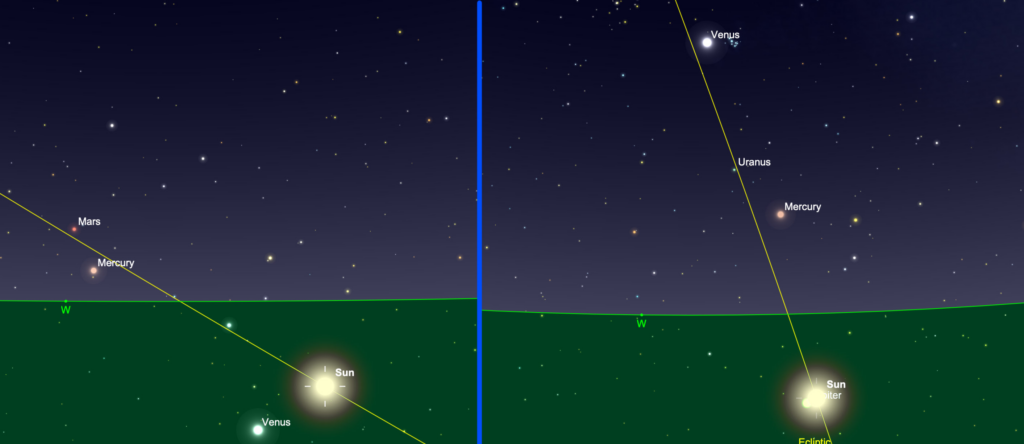Sky Report: April 10 – 16, 2023

Left: Mercury at its greatest separation from the sun on August 10, 2023, and at right at its greatest separation on April 11, 2023, both 45 minutes after sunset. The difference in Mercury’s altitude is due to the angle the ecliptic (yellow line) makes with the horizon, and that angle changes with the seasons. Note the Pleiades near Venus on April 11. Graphic created with SkySafariAstronomy.com.
This is the best week this year to see the elusive planet Mercury. Mercury never strays far from the sun and you can see it only in the morning, just before sunrise, or in the evening, just after sunset. Speedy Mercury orbits the sun in 88 days, so it reappears several times each year, but all appearances are far from equal and the attached graph shows why. Visualize the ecliptic, the path of the planets, which we see edge-on. The planets follow near it. But, because the earth is tilted on its axis, the angle the ecliptic makes with the horizon changes through the year; in spring that angle is steep and in the fall it is shallow. (The sun follows the ecliptic and this is also the reason why the sun is high in the summer and low in the winter.) So in the spring, 45 minutes after sunset, Mercury stands relatively high above the western horizon while in the fall Mercury may be the same angular distance from the sun 45 minutes after sunset but it is very low.
Mercury’s greatest angular separation from the sun – 19° — comes on the 11th, but it heads back toward the horizon surprisingly quickly (it’s moving between the earth and sun) and we’ll lose it before this week is over. Look very low in the north-northwest – where the sun has just set — and pick a spot with a low horizon.
Venus is 20° or so above Mercury and it’s the brightest thing in the night sky after the moon. It sets 3-1/3 hours after the sun so it shines in a very dark sky after twilight ends. Then look at the Pleiades Star Cluster, aka The Seven Sisters, which Venus passes. Venus is 2½° from the center of the Pleiades on the 10th and 11th, 3° on the 12th, 4° on the 13th, and so on. Be sure to watch Venus nightly to watch it pass this prettiest of star clusters, and of course any binoculars will greatly enhance the view.
Recently Jupiter was below Venus and only a few weeks ago they made a really pretty pair. On the 11th Jupiter is behind the sun and officially moves from the evening to morning sky. We’ll see it reappear before sunrise in early June.
The third planet you’ll see, after Mercury and Venus, is Mars, which is very high in the west during the early evening, then lower as the hours pass, not setting until 2 a.m. Mars is making its way eastward through the Gemini twins. It’s starting to leave the Milky Way but there are still plenty of bright stars nearby, most noticeably Castor and Pollux which are above it. On the 14th the star Epsilon Geminorum is a scant ¼° from Mars. This star helps define Castor’s body if you look for people in the sky. Castor and his brother Pollux were familiar action heroes in ancient times and everyone knew their adventures.
The Sky Report is presented as a public service by the Stellar Vista Observatory, a nonprofit organization based in Kanab, Utah, which provides opportunities for people to observe, appreciate, and comprehend our starry night sky. Additional information is at www.stellarvistaobservatory.org. Send questions and comments to John@StargazingAdventures.org.
Stellar Vista Observatory provides portable telescopes and tripod mounted binocular kits on loan for free to residents and visitors in Kane County. Enhance your enjoyment of the night sky! To learn more, request a loan, or attend one of SVO’s free public star parties for 2023, visit https://stellarvistaobservatory.org/ or drop in to the Kane County Office of Tourism.






Comments are closed.